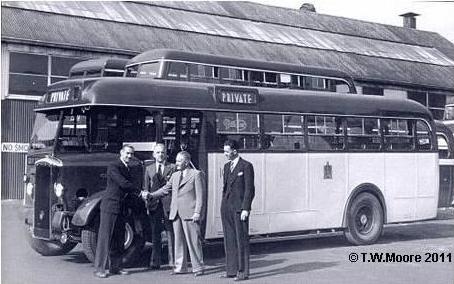


CVD6 Single-Decker GKV101 on delivery to Harnall Lane Garage
When we talk about Coventry Corporation Transport buses it is easy to forget the single-deckers, there being so few of them compared with the double-deckers. Consequently, they were less often seen about town, but each of them played its part in the fleet. Probably the most well known single-deckers were the post-war Daimler CVD6s.
They sounded great, rode smoothly, being powered by Daimler 8.6 litre engines linked to the fluid flywheel preselector gearbox and they were a treat to travel in. I was reminded of their quality ride and sound when I travelled to the P.O.P.'s Rally, at Wedgewood, in the ex Exeter C.T. Daimler CVD6 single-decker, thanks to Roger Burdett. It was wonderful! The CCT CVD6's were numbered GKV 101-108 and HKV 109-116, ordered in two batches and all delivered between 21st July and 1st November 1949. The chassis numbers of 101-108 were 14462-14469 following on from Daimler CVA6 GKV 95. The chassis numbers of 109 to 116 were 14689-14696 showing a gap of 20 chassis supplied elsewhere by Daimler, after 108 and before 109.
Brush built the B34F bodies of the CVD6's. A disappointing feature on 101-107 and 110 was the half dropped window vents. Thankfully, 108 and 111-116 had the neater narrow type. The livery in reversed colours suited the buses. Inside, the higher back seating set quite a high standard for stage carriage.
These 16 CVD6s replaced the complete CCT single-decker fleet of Daimler COG5/40s, 146,174-178, 206-211 and 242-244 together with the utility Roe bodied Bedfords, 291-298, all by October 31st 1949. The newest of these buses 242-244 and 291-298 were only 8 or 9 years old. Phil Groves described them in his 'Coventry Scene' article in Buses Illustrated Nos. 142, 144 and 146 as comparatively young buses to be withdrawn in early post-war years. I must mention 244 of this list, as we all wait in anticipation for its 'rebirth'. To see it take to the Coventry streets again will be a great occasion all thanks to Roger Burdett.
You could depend on seeing one of these Daimler CVD single-decker buses working the Berkswell service from Pool Meadow, but, they were mostly seen helping out at peak time. In the CWK205 forum, it has been mentioned that for years, three of these buses travelled to Bitterswell each day on works services. Two remained at Bitterswell and one returned to base with the crews, returning again at the pm peak. In addition, of course, they were used on private hire including the Outer Circle service. Phil Groves, author of many CCT writings, recalled that much of the private hire was over substantial distances. So much so, three of these buses 111,113 and 114 were sent to S.H.Bond of Manchester in 1954 to be re-furbished with coach seating, reducing their seating capacity from 34 to 30. New features were luggage racks, lighting and heaters, together with chrome strips fitted along each side, which enhanced the outer appearance. The old seats from these buses, already described above as 'high quality' were fitted to Daimler COA6 213 and Guy Arab 305 thus creating the most comfortable double-decker buses in the fleet.
Colin Holloway, in the CWK205 forum wrote "The CVD6 single-deckers were very nice buses to drive". I should imagine they were powerful too, yet I understand the top speed was 45mph. Had the engines been de-rated or governed, RHMS and Bunty coaches with the same engine sped along at up to 60mph, so it must have been frustrating for the CCT drivers on private hire duties. Or am I delving into different back axle and alternative gear ratio's and engine revs that differs between a coach and a bus (I'm not mechanical, it was just a thought, so I'll move on, but I'd like to know). (Editors note: I believe that stage carriage buses were severely limited by law in the 1950s. My recollection is that the CVA6 double-deckers carried a speed limit notice on the bottom of the near-side panel indicating a maximum speed of 30 mph.)
The first of the CVD6's withdrawals was in 1962 and the last was sold off in 1965. 102 became the 'Lila' bus in February 1963 and transferred to the Coventry Welfare Committee to take OAPs on social outings, painted in two-tone blue and named after the Lady Mayoress, wife of Lord Mayor Alderman J. Waugh, a great Lord Mayor and Lady Mayoress of Coventry at that time. Lila was maintained by CCT and could be seen around the city for the next 10 years until sold to Georges Coaches of Longford around 1972/3.